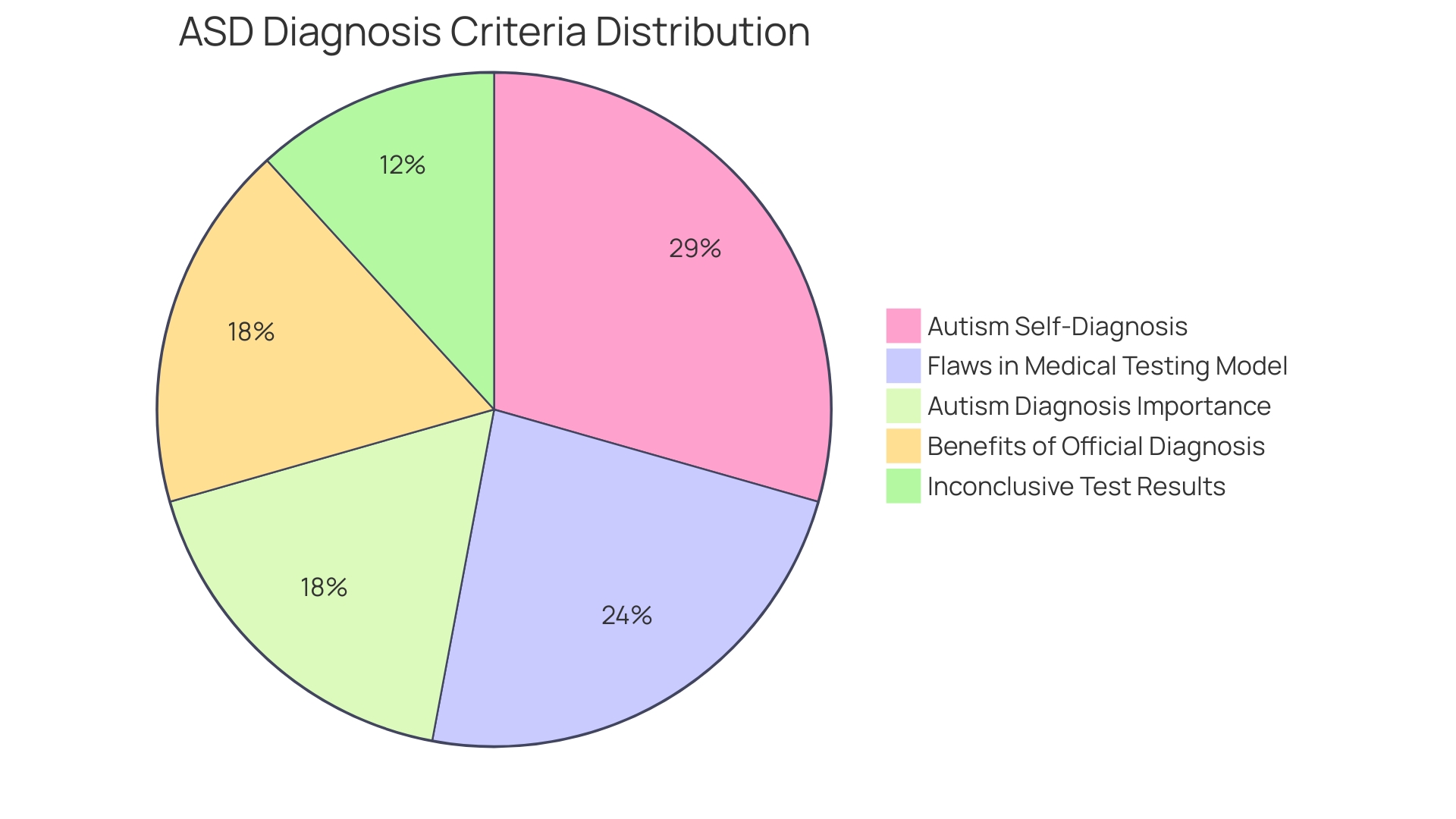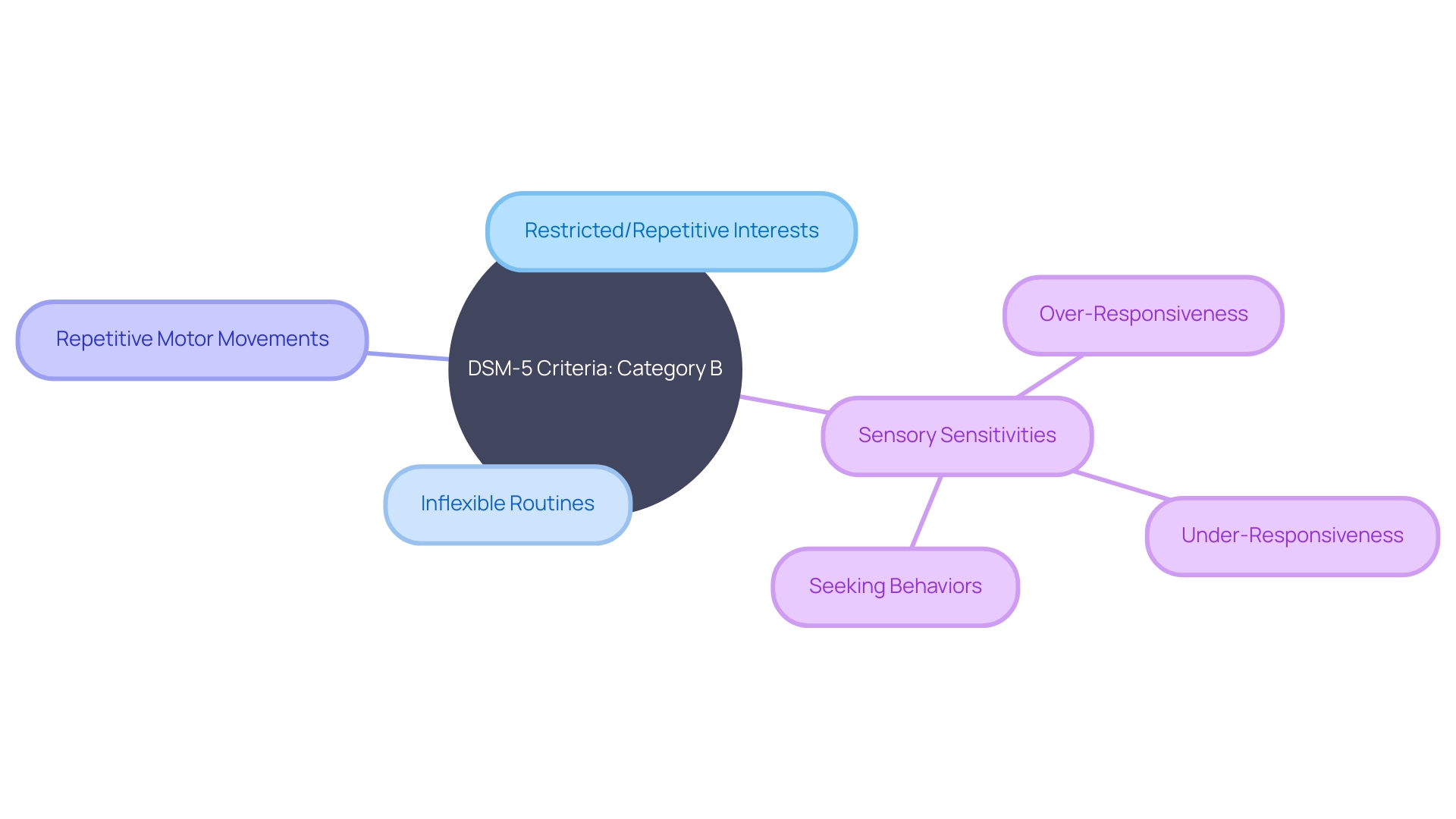Introduction
The Diagnostic and Statistical Manual of Mental Disorders (DSM-5) is a crucial resource for diagnosing mental health conditions, including Autism Spectrum Disorder (ASD). Understanding the criteria outlined in the DSM-5 is essential for parents, educators, and healthcare professionals to recognize the signs of autism and seek appropriate interventions for children. This article will explore the specific criteria for diagnosing ASD, including social communication deficits, repetitive behavior patterns, and the impact on daily functioning.
It will also address the importance of recognizing the lifelong nature of autism and the need to differentiate it from other developmental disorders. Additionally, the article will discuss the limitations of the DSM-5, the diversity within the autistic community, and the comparison to other diagnostic systems. Stay tuned to gain valuable insights into navigating the world of autism!
Understanding the DSM-5
The Diagnostic and Statistical Manual of Mental Disorders, 5th Edition (DSM-5) is a widely used manual for diagnosing mental health conditions. It provides a comprehensive framework for identifying and classifying different disorders, including Autism Spectrum Disorder (ASD). Understanding the DSM-5 is essential for parents, educators, and healthcare professionals to gain insights into the criteria and characteristics of autism.
DSM-5 Criteria for Autism Spectrum Disorder
The DSM-5 provides specific criteria for diagnosing Autism Spectrum Disorder (ASD). These criteria include social communication and social interaction deficits, repetitive patterns of behavior, symptoms present since childhood, degree of impact on daily functioning, and traits not better explained by intellectual disability. By understanding these criteria, parents can better recognize the signs and seek appropriate interventions for their children.

Category A: Social Communication and Social Interaction
Category A of the DSM-5 criteria focuses on social communication and social interaction deficits. It includes difficulties in initiating and maintaining conversations, understanding nonverbal cues, developing and maintaining relationships, and lack of social-emotional reciprocity. Recognizing the challenges in this category can help parents identify the need for social skills interventions and supports.
Category B: Repetitive Patterns of Behavior
Category B of the DSM-5 criteria encompasses repetitive patterns of behavior. It includes restricted and repetitive interests, inflexible routines, repetitive motor movements, and sensory sensitivities. Understanding these behaviors can assist parents in finding strategies to manage and support their children's needs.

Criteria C: Symptoms Must Be Present Since Childhood
Understanding the hallmarks of autism is critical for accurate diagnosis and in illustrating that the symptoms are not transient but part of the lifelong nature of the condition. A core component of an autism diagnosis is that the signs must be visibly present from an early age.
This crucial aspect serves to distinguish autism from other developmental disorders. The lifelong journey with autism spectrum disorder (ASD) is underscored by recurring patterns of behavior and persistent challenges in social communication, which are consistent throughout a person's life.
With awareness of autism more prevalent due to public health efforts and advocacy, the prevalence of 1 in 45 adults diagnosed with ASD in the U.S. shows a society recognizing the condition more than ever. Indeed, many adults might have ASD without a formal diagnosis or may have been previously misdiagnosed. For these individuals, familiarizing themselves with the common indicators of autism is a pivotal initial step towards identifying potential undiagnosed ASD in themselves or a loved one. Acknowledging the signs, which include difficulties in social interactions and restrictive, repetitive behaviors, can lead to a deeper understanding of the condition in adults, akin to how it appears in children.
Criteria D: Degree to Which Autism Affects Daily Functioning
An important aspect of the DSM-5 is its acknowledgment of the diverse support needs individuals with autism may have due to varying levels of difficulty in communication, social interaction, and cognitive functioning. However, a critical review of non pharmacological interventions for children and youth with autism highlights a history of research studies rife with design flaws.
These issues cloud our understanding of the interventions' effectiveness, the range of change they can induce, the possibility of unintentional harm, and the community's engagement in the intervention's development and implementation. A nuanced understanding of these research issues is vital not only for individuals with autism but also for the broader community requiring support in hearing and speech. Over the years, the autism community has been at the forefront, advocating for better research standards and ethics in intervention studies, recognizing that the credibility of such research is not just an academic concern but one that reflects the fundamental respect for individuals with autism.
Criteria E: Traits Not Better Explained by Intellectual Disability
In evaluating a child for potential autism spectrum disorder (ASD), it's crucial to recognize that traits indicative of ASD must be distinguished from those solely related to intellectual disability. Specifically, there is a consideration for conditions like Auditory Processing Disorder (APD), which can impact how the brain interprets sounds, distinct from conventional hearing loss that arises from ear damage.
Known as well as Central Auditory Processing Disorder, APD can occur at any life stage but is commonly identified in both children and older individuals. Assessment for autism, therefore, must be holistic, accounting for overlapping conditions such as APD, ADHD, or other factors that could influence a child's auditory processing and comprehension abilities.
Interpretation and Limitations of DSM-5 Criteria
Autism diagnosis, guided by criteria such as the DSM-5, is not a one-size-fits-all process. Each individual facing the spectrum exhibits distinct characteristics, and it's crucial to consider these personal attributes when applying diagnostic standards. The DSM-5 serves as a beacon for clinicians to tailor assessments and interventions specific to each person's strengths and challenges.
Moreover, it's vital to acknowledge the diversity within the autistic community and their openness to self-diagnosis, particularly when formal medical testing sometimes yields inconclusive results. Recognizing signs of autism is the initial step towards understanding and embracing one's identity on the spectrum, whether through self-identification or formal diagnosis. This informed approach to autism reflects the intricacies of interdisciplinary research from various experts, illustrating the multi-faceted endeavor to comprehend the spectrum better.
Comparison to Other Diagnostic Systems (ICD-10)
It is worth noting that the DSM-5 criteria for autism differ from the International Classification of Diseases, 10th Edition (ICD-10) criteria. The ICD-10 may have additional or slightly different criteria for diagnosing autism. Parents should be aware of these differences when seeking assessments and support services.
Conclusion
In conclusion, understanding the DSM-5 criteria for diagnosing Autism Spectrum Disorder (ASD) is crucial for recognizing the signs, seeking appropriate interventions, and ensuring the well-being of individuals with autism. The criteria encompass social communication deficits, repetitive behavior patterns, and the impact on daily functioning. By familiarizing themselves with these criteria, parents can better recognize the signs and advocate for their children's needs.
It is important to remember that autism is a lifelong condition, and early signs must be present since childhood, distinguishing it from other developmental disorders. Understanding the diverse support needs of individuals with autism is essential, as it allows for tailored interventions and support. While the DSM-5 has its limitations, it is vital to acknowledge the diversity within the autistic community and their openness to self-identification.
Recognizing the signs of autism is a significant step towards understanding and embracing one's identity on the spectrum, whether through self-identification or formal diagnosis. Lastly, it is worth noting that the DSM-5 criteria may differ from other diagnostic systems such as the ICD-10, highlighting the importance of considering these differences when seeking assessments and support services. By applying the DSM-5 criteria, parents, educators, and healthcare professionals can navigate the world of autism and provide the necessary support for individuals with autism to thrive.




